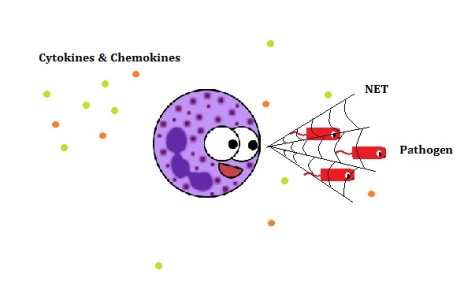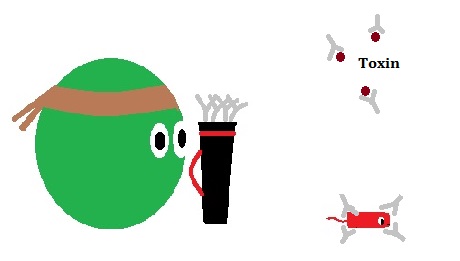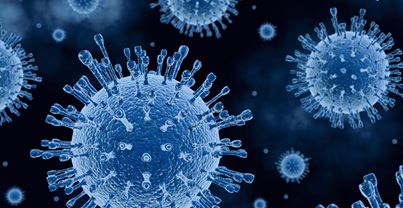Our bodies are constantly being exposed to micro-organisms, every second of every day, from the air we breathe to the food we eat. In fact there are more bacterial cells in your body than there are human ones! So why aren’t we always sick? Well first of all, although microbes often get a bad rap, not all of them are harmful. Perhaps surprisingly, many of them are even beneficial to health. The ones that are harmful are known as pathogens and although they frequently try to colonise our bodies, there is an army of cells fighting to protect you from the illnesses and infections they cause. Your own personal defence force. Meet the immune system.

Your immune system is made up of leagues of different cell types all with a variety of jobs to keep you fit and healthy. If the immune system is the army, then your body is the country which they will loyally defend to their dying breathes. When a pathogen breaches the body’s borders, the immune system will quickly leap into action to destroy the invader.
The first lines of defence are actually deterrents that prevent microbes from entering the body in the first place. This includes both physical and chemical barriers such as your skin, mucus and stomach acid. Like trenches and barbed wire on a real battle field, these barriers can block, trap or destroy invading pathogens before they can pose a threat. If an unwanted microbe does manage to overcome these barriers, one of the first cells to come to your aid will be the neutrophils.
At the first signs of an infection, neutrophils head straight into battle and mount a defence whilst the rest of your body prepares the offensive. Neutrophils will engulf any invaders in their path and destroy them in acidic compartments in a process known as phagocytosis. They can also release substances known as cytokines, chemokines and anti-microbial peptides. These are small chemical weapons which can both damage the invaders directly and signal to other cells for back up in a similar fashion to grenades or smoke bombs. Finally, if all that fails, the neutrophils can self-destruct and throw out a neutrophil extracellular trap, quite nicely shortened to NET. These NETs can trap invading pathogens to prevent them from spreading further into body. They are also harmful to microbes thanks to the high concentration of anti-microbial peptides released within them.

The supporting troops, signalled by the smoke bombs (or cytokines and chemokines), then rush to join the battle. These usually take the form of macrophages. Macrophages are the main cell type that can engulf and destroy microbes via phagocytosis and as such, they are extremely important in keeping pathogens at bay.

As well as being involved in the initial war against invading microbes, macrophages are also crucial in attracting and activating other cells via the release of their own cytokines and chemokines.
Then there’s the scouts, the dendritic cells, which arrive, survey the scene and take information back to the army’s HQ to prime the next wave of soldiers. Like macrophages, dendritic cells can internalise, kill and present parts of the invading microbe on their cell surface but instead of remaining at the battle ground, the dendritic cells return to the army’s HQ, the lymph nodes and pass this information on to the waiting T cells and B cells. Like any army, the main ground force (here the B & T cells) needs time to prepare for battle before it can be mobilised. In the body, this takes the form of B & T cell activation. When a dendritic cell arrives at the lymph node, it will head to the T cells and share information about the invading pathogen with them via the T cell receptor. Each T cell is specialised to recognise and fight one particular pathogen. Only the T cells which recognise that pathogen are activated by the dendritic cell to ensure that your body only sends out the best soldiers for the job.

Once activated, the specialist T cell starts to divide and will give rise to a clone army of T cells that recognise the pathogen in question. These newly activated T cells are the foot soldiers that are sent out to the battle ground to fight the infection.
There are two types of T cell that are recruited to the on-going battle of the body. The first are ruthless killers, the aptly named natural killer cells. Natural killer cells work mainly against viruses and kill any of your body’s own cells that are infected by the virus. This may sound counterproductive, but invading viruses take over your cells and use them as factories to produce more virus particles. Destroying the factory halts virus production and makes it easy for the immune system to eradicate the virus before it spreads to other cells in your body.
The next are T helper cells. As the name suggests, T helper cells aid other cells in becoming better at destroying pathogens. They can make our innate cells, such as macrophages, more phagocytic (better at engulfing and destroying microbes) and are essential for activating B cells.
If T cells are the foot soldiers, then B cells are the archers. Each B cell has a specific set of arrows that are effective against a particular pathogen. When a dendritic cell presents part of this pathogen to the appropriate B cell, with a little help from the T helper cells, this B cell will grown and divide to generate an army of clone B cells which use that particular arrow. These arrows, more accurately known as antibodies, play a variety of important roles in the battle of body. For one, antibodies can bind to and neutralise circulating toxins produced by the pathogen thereby preventing lots of nasty symptoms. They can also bind directly to pathogens and prevent them from interacting with or entering other cells in our body. They can also make it easier for the pathogen to be phagocytosed by the likes of neutrophils, macrophages and dendritic cells.

The cells that we consider our first lines of defence; the neutrophils, macrophages and dendritic cells, are known as our innate immune system. This is the non-specific, rapid acting arm of our defence force. Most of the time, this innate system is sufficient to clear the invader on its own. If the innate immune system isn’t enough however, the slower, more specific part of our immune system, the B cells and T cells, will come to our aid. This is our adaptive immune system. An important feature of the adaptive immune system is that it exhibits memory. If you’re infected with the same pathogen twice, the second time round, your body is much quicker at recognising and destroying the pathogen. This is why most people will only develop chicken pox once. The second time, your body is ready and your memory T cells and B cells from the first infection can jump into battle before the virus has time to make you sick. Although these two arms may seem very distinct, in reality, they act in a highly co-ordinated manor with lots of cross-over. This allows them to effectively defend our bodies from the threats they encounter every day and ensure that you’re fit and healthy enough to sit here and read my blog!
Although I could write for weeks about the intricacies of the immune system and all the different jobs and sub-classes of cells, I hope you enjoyed this short overview of what I like to call the battle of the body! As always, let me know what you thought in the comments or on Twitter and feel free to ask me any questions you may have.


A meaty post, packed with protein! Seriously you packed a lot in there. Good one!
LikeLiked by 1 person
Thank you Ben. It’s hard to know where to stop with that one. I’ve done an entire degree on it. I could write all day.
LikeLiked by 1 person
I’ve always wondered how something like an immune system evolved. It makes sense to say an organ or tissue developed because of evolution. But a “system” is another thing. An organ is a system, simply rooted in the physical. But nothing like an “immune organ” exists. Several organs and tissues work in concert to defend the body, but no actual dedicated organ. Weird really. We have a blood pumping organ, an administration organ and a metabolising organ. To say bodily defence is complex is true, but then so is consciousness, and that has a single locus. Makes me wonder sometimes….
LikeLiked by 1 person
This is the kind of topic you could easily get lost in! It’s so interesting to ponder how such an essential, complex system evolved.
There are some features of the immune system that seem to be conserved across almost all species suggesting they evolved very early on in life’s development. The ‘Toll’ pathway for example is found in both plants and animals and many of the immune-related genes in flies have comparative genes in mice and humans. They could of course have evolved separately but the similarities and conservation between species is remarkable.
It’s also been noted that simple organisms like amoeba act in a very similar manor to macrophages. This could indicate that our phagocytes originated as amoeba-like unicellular organisms. We may not ever know the full picture but it’s an exciting story to follow.
LikeLiked by 1 person
It sure is. I’m sure it’s somehow analogous to the means by which primitive bacteria became our mitochondria.
LikeLiked by 1 person
If only we could go back and watch life evolve. That would be the greatest movie of all time! I find that stories of the past such as the emergence of life, the big bang, evolution etc., always excite me way more than stories of the future. The curiosity is killing me.
LikeLiked by 1 person
Amen to that brother! What I wouldn’t give!
LikeLiked by 1 person